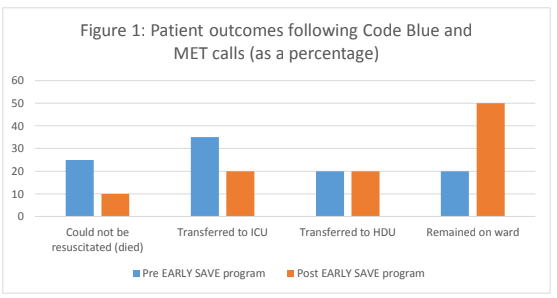Assessment task 4: Research / evidence-based practice paper
Part 1 : CNA153 Foundations for Professional Practice 2 Assignment
You are working as a registered nurse in a large metropolitan hospital. The hospital has introduced the ‘EARLY SAVE’ program to reflect best practice in early recognition and response to clinical deterioration in addition to the existing Code Blue process for severe/life threatening medical emergencies. The program includes education for clinical staff, a more formalised Medical Emergency Team (MET) process, and the introduction of an Observation and Escalation Chart.
Figure 1 presents the patient outcomes following a Code Blue or MET call from data collected before the introduction of the program (Pre EARLY SAVE) and data collected over the same length of time post the introduction of the program (Post EARLY SAVE).

There were 160 MET calls in the pre period, and 360 in the post period. In the pre period, the reasons for calling the MET included seizure/fitting (20%); worsening respiratory function (20%); acute respiratory distress (25%); suspected cardiac pain (20%); and alteration in vital signs indicating clinical deterioration (15%). In the post period, the reasons for MET calls included worsening respiratory function (30%); acute respiratory distress (10%); a seizure or fitting (20%); suspected cardiac pain (10%); and alteration in vital signs indicating clinical deterioration (30%).
There were 140 Code Blue calls pre EARLY SAVE and 60 post, mainly for cardiac or respiratory arrest.
1. Based on the data presented, do you think the EARLY SAVE program has been effective in
improving early recognition and response to clinical deterioration in your hospital? Why/
why not?
2. How might the data obtained pre and post the EARLY SAVE program be used by the
hospital when reporting against National Safety and Quality Health Service (NSQHS)
Standard 9: Recognising and responding to clinical deterioration in acute health care?
Part 2 : CNA153 Foundations for Professional Practice 2 Assignment Solution
Should family members be allowed to be present during the resuscitation of their loved one in the acute care setting? Why, or why not? Please ensure that you refer to the highest possible levels of research evidence available to justify your answer.



